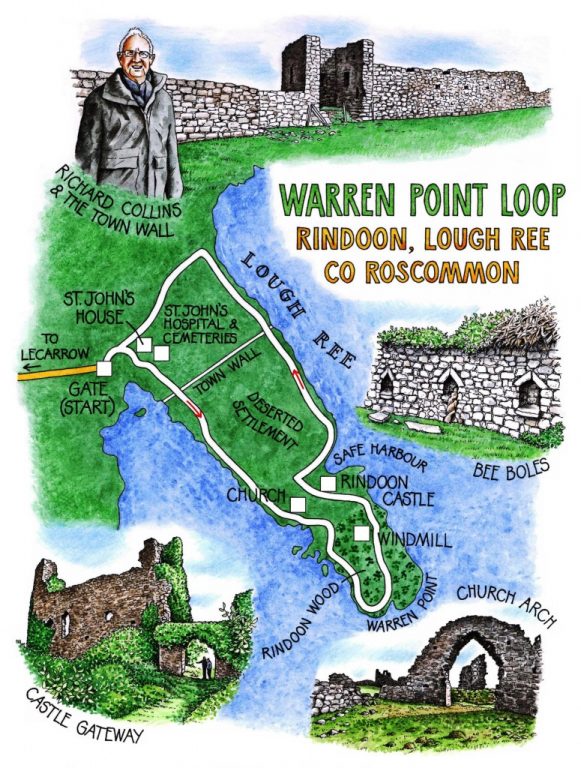Irish Independent – WALK OF THE WEEK – Christopher Somerville
28 May 2011
97. Warren Point Loop, Rindoon, Lough Ree, Co. Roscommon

County Roscommon’s green peninsula of Rindoon, jutting from the western shore of Lough Ree, is an edge-of-the-world sort of place with one solitary dwelling, St John’s House. Richard Collins grew up in this handsome Georgian house, and now runs it with his wife Liz as a peerless guesthouse. The previous night, over some beautiful roast lamb, Jane and I had learned some of the secrets of this remarkable promontory. Now, setting out with Yoda the blond Labrador into a bright day and a blasting wind, Richard steered us along the lake margin into the half forgotten world of Rindoon.
This small peninsula, just under 2 km long and not much more than 500 metres wide, contains one of Ireland’s finest archaeological sites: a medieval township complete with church, castle, harbour and turreted town wall. It’s been described as ‘a storybook in stone’ – a book that few have ever read. Unlike the vast majority of Ireland’s medieval towns, the ruins of Rindoon have not been built on or greatly disturbed since the settlement was abandoned some 500 years ago. Few outsiders make their way here. Richard’s childhood was spent exploring this magical forgotten place and its monuments, draped and half-concealed under giant growths of ivy. Since then, he and like-minded colleagues have done their best to shore up and preserve the walls of Rindoon, stripping back the ivy, mending and restoring the great towers.
‘There was a covered walkway for the sentries,’ said Richard as we walked the town wall that the Normans built as a barrier across the thick neck of the peninsula. ‘Tall slit windows for archers – see them?’ We stopped by Tower 3, an open-backed turret restored with stone taken from the nearby lake. This section of wall, rebuilt and de-ivied, stood twenty feet high. But further along we could see broken gaps where enormous shaggy mats of ivy bristled like a monstrous green eyebrow. In winter gales the wind tugs at this sail-like mass with force enough to pull any weak sections of wall clean over.
We walked on along the lakeside path among a litter of white boulders, the wind driving wavelets ashore with a continuous rustle. The tree-covered islands out in Lough Ree lay low and tree-smothered on the horizon. Inland the peninsula ran in green hummocks, its houses and streets sunken below the fields. The shell of the parish church still stands, though. Richard sat in the stone recess that had once been the priest’s sedilia, indicating the rough-built sanctuary arch. ‘You couldn’t even see this arch when I was a boy; it was smothered completely with ivy, right down to the ground.’
The arch framed another ruin on the skyline, the enormous hulk of Rindoon Castle. We arrived there by way of a beautiful flowery path through the hazel and oak trees of Rindoon Wood. On the eastern flank of the wood the weatherbeaten stone cylinder of an old windmill stood among trees on a grassy mound – an unacknowledged rath, Richard believes.
Rindoon Castle is an extraordinary sight, a great fortress whose towers and gateway, curtain walls and window arches and fireplaces all loom in the embrace of the ivy like a stage set for a Sleeping Beauty. However strong it looked, though, the castle and its garrison couldn’t protect Rindoon from one Irish raid after another. By 1342 town and castle were under Irish control.
For the first hundred years of its existence the castle was systematically repaired and improved. After that it was a tale of slow decline. Once cannon had been introduced to Ireland early in the 15th century, castles became redundant. From the 16th century onwards Rindoon was in English hands, but the castle was a ruin by then.
Back near St John’s House we came on the tumbledown, barn-like building of the Hospital of St John, run by the order of Crutched Friars in Rindoon’s heyday. In the orchard wall nearby were three curious recesses under pointed arches – bee boles, said Richard, installed by the monks. Each bole would have held a straw skep full of bees to fertilize the fruit trees, and as a source of sugar and candlewax.
The touching intimacy of the image seemed to bring old Rindoon very close. Walking here, you sense past and present as closely interleaved. And the future might see a proper restoration and wider recognition of this national treasure, if Richard Collins and friends can realise their dream.
WAY TO GO
MAP: OS of Ireland 1:50,000 Discovery 40; downloadable map/instructions (highly recommended) at www.discoverireland.ie/walking.
GPS: satmap.com
TRAVEL:
N61 Athlone-Roscommon; in Lecarrow, right by Coffey’s pub (sign: ‘Rindoon Castle’). On right bend in 3 km, park by trailhead map at gate of St John’s House.
WALK DIRECTIONS: Through gate, down drive; keep right of St John’s House, and follow blue arrows round the peninsula and back to the start.
LENGTH: 3 miles: allow 2 hours
GRADE: Easy
CONDITIONS: Field and woodland paths; wet/muddy in spots
DON’T MISS … !
• Town Wall and Towers
• Rindoon bluebell wood
• Parish church, windmill, castle and St John’s Hospital
REFRESHMENTS: Picnic (packed lunch if staying at St John’s House)
ACCOMMODATION: St John’s House, Rindoon, Lecarrow, Co Roscommon (090-666-1748; www.stjohnshouse.biz): friendly, helpful, comfortable
READING: Lough Ree and Its Islands by Sean Cahill, Gearoid O’Brien and Jimmy Casey (Three Counties Press 2006)
WALKING in IRELAND: Walking tour operators, local walks including Discover Ireland’s National Loop Walks, walking festivals throughout Ireland: www.discoverireland.ie/walking.
INFORMATION:
Roscommon Tourist Office: Harrison Hall (090-662-6342);
discoverireland.ie/places-to-go-location/roscommon/22
csomerville@independent.ie